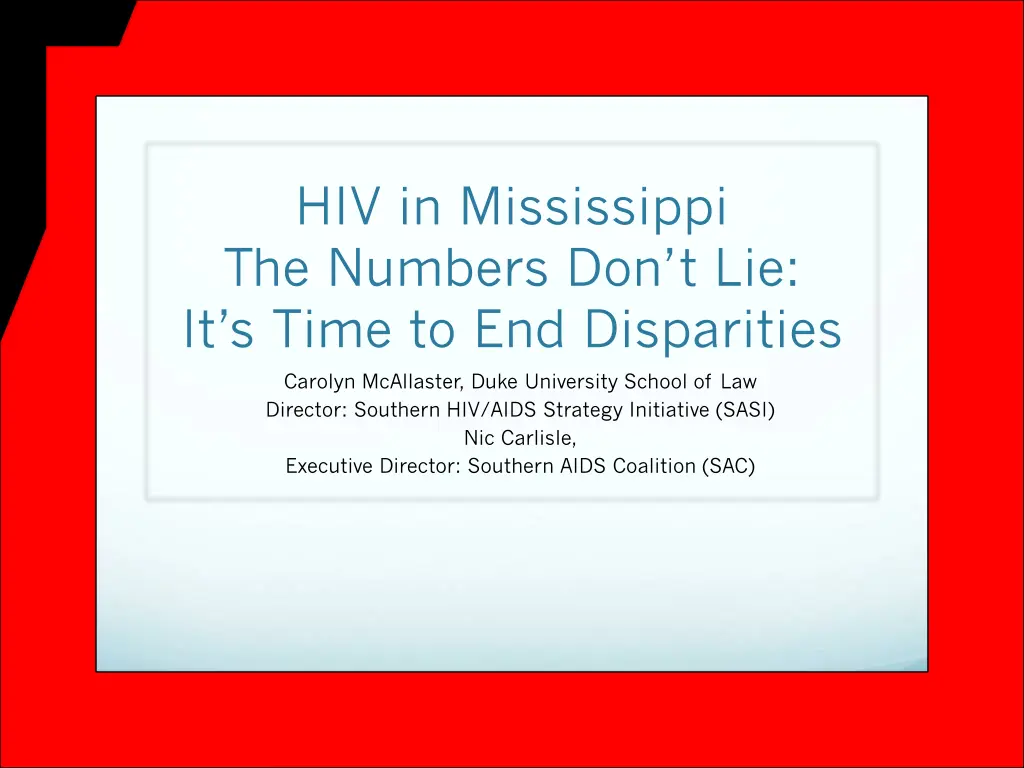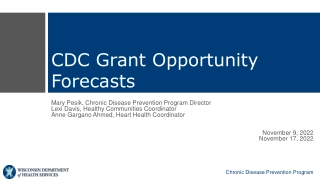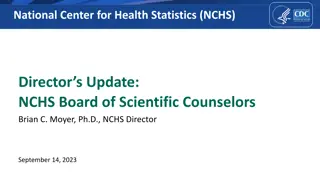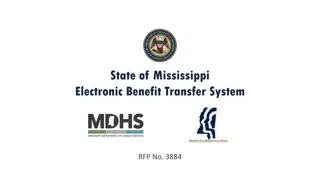
Understanding HIV Disparities in Mississippi
Learn about the alarming HIV statistics in Mississippi, including high rates of new diagnoses, deaths, and individuals living with HIV. Explore the Southern HIV/AIDS Strategy Initiative's analysis of CDC funding and disparities, aiming to end differences in HIV prevention services for those most in need.
Download Presentation

Please find below an Image/Link to download the presentation.
The content on the website is provided AS IS for your information and personal use only. It may not be sold, licensed, or shared on other websites without obtaining consent from the author. If you encounter any issues during the download, it is possible that the publisher has removed the file from their server.
You are allowed to download the files provided on this website for personal or commercial use, subject to the condition that they are used lawfully. All files are the property of their respective owners.
The content on the website is provided AS IS for your information and personal use only. It may not be sold, licensed, or shared on other websites without obtaining consent from the author.
E N D
Presentation Transcript
HIV in Mississippi The Numbers Don t Lie: It s Time to End Disparities Carolyn McAllaster, Duke University School of Law Director: Southern HIV/AIDS Strategy Initiative (SASI) Nic Carlisle, Executive Director: Southern AIDS Coalition (SAC)
HIV and AIDS Statistics in Mississippi Mississippi ranked 8th in the country in the rate of new HIV diagnoses in 2014. Mississippi ranked 7thin the country in the rate of deaths among people with HIV in 2013. Mississippi ranked 9thin the country in the rate of people living with HIV in 2013. (CDC Atlas Data, http://www.cdc.gov/nchhstp/atlas/)
SASI Analysis of CDCs recent FOA for direct CBO funding (PS15-1502) PS15-1502 CDC funding designed to reach areas with greatest need for HIV prevention services. Restricts eligibility for direct funding to community based organizations (CBOs) to those located in designated metropolitan statistical areas CBOs outside those areas are not eligible to apply for funding.
SASI Analysis of % of PLWHA Living Outside an MSA eligible for CBO Funding from CDC 63.01% 27.61% 69.96% 57.45% 34.20% 68.41% 21.56% 21.25% 32.39% Percent HIV+ Population Not Living in MSA 0-20% 20-40% 40-60% 60+%
SASI Analysis of Funds Distributed to community based organizations in the US under the recent CDC funding opportunity (PS15-1502) PS15-1502 FUNDING DISTRIBUTION All Other States 31% South 33% NY/California 36%
Comparison of new HIV diagnoses NEW HIV DIAGNOSES IN THE US All Other States 30% South 51% NY/California 19%
Comparison of HIV Prevalence HIV PREVALENCE IN THE US All Other States 30% South 43% NY/California 27%
CDCs Recent Funding Allocation to CBOs Summary Region/State Total PS15-1502 Funding Amount Received Percentage of Total US PS15-1502 Funding Received 100% Percentage of new HIV diagnoses in US (2013) Percentage of People Living with HIV in US (year-end 2012) [1] United States $40,615,001 100% 100% South $13,483,383 33% 51% 43% Deep South Region $10,683,383 26% 40% 34% Florida $1,050,000 3% 11% 11% New York & California $14,794,561 36% 19% 27%
PS15-1502 Funding Eligibility in Mississippi Under PS15-1502, only CBOs in the Jackson metropolitan area are eligible to apply for HIV prevention funding from the Centers for Disease Control and Prevention (CDC). CBOs in other Mississippi cities are not eligible for funding.
Consequences for Mississippi 57.46% of people living with HIV in MS live outside of the Jackson metropolitan area that are not eligible to apply for funding. Only one Mississippi-based CBO received funding pursuant to PS15-1502.
Conclusions from SASI Analysis Recent CDC funding to CBOs is inconsistent with the geographic distribution of the epidemic both within states and between regions. Additional resources are needed for the South and within the South, for the large urban centers and the rural and smaller urban areas with heavy HIV burden.
SASI/SAC Toolkit Take Action Write to CDC Prevention Director, Dr. Eugene McCray Letters to be delivered in bulk in April. 2-page Fact Sheet: Impact of Recent CDC Funding on Southern CBOs Mississippi Fact Sheet Stationery and envelopes
Collect your own letters. Toolkit on our website: http://southernaidsstrategy.org/take-action/ Campaign introductory letter 2-pager on Impact of CDC Funding State-based fact sheet Power point slides Longer Report for more details
Follow the Work of the Southern HIV/AIDS Strategy Initiative (SASI) and the Southern AIDS Coalition (SAC) Visit SASI s website www.southernaidsstrategy.org Visit SAC s website http://southernaidscoalition.org/






















